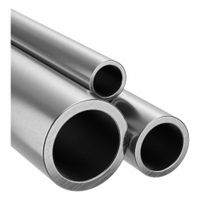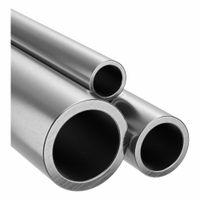Call +(254) 703 030 000 / 751 483 999 / 721 704 777
- Home
- Raw Materials
- Metals
- Stainless Steel
- Stainless Steel Tubes
.....Read More
Frequently Asked Questions
What are the different grades of stainless steel tube stock?
Stainless steel tube stock is available in various grades, each with distinct properties suited for specific applications. The primary grades include:
1. **Austenitic Grades**:
- **304/304L**: Known for excellent corrosion resistance and formability, widely used in food processing and chemical industries.
- **316/316L**: Contains molybdenum for enhanced corrosion resistance, especially against chlorides, making it ideal for marine and pharmaceutical applications.
2. **Ferritic Grades**:
- **409**: Offers good oxidation and corrosion resistance, commonly used in automotive exhaust systems.
- **430**: Known for good corrosion resistance and formability, often used in kitchen appliances and decorative applications.
3. **Martensitic Grades**:
- **410**: Provides high strength and moderate corrosion resistance, suitable for cutlery and surgical instruments.
- **420**: Known for higher carbon content, offering increased hardness, used in cutlery and dental instruments.
4. **Duplex Grades**:
- **2205**: Combines high strength with excellent corrosion resistance, used in chemical processing and oil & gas industries.
- **2507**: A super duplex grade with superior strength and corrosion resistance, ideal for harsh environments.
5. **Precipitation-Hardening Grades**:
- **17-4 PH**: Offers high strength and corrosion resistance, used in aerospace and chemical industries.
6. **Specialty Grades**:
- **904L**: High alloy austenitic stainless steel with excellent corrosion resistance, used in aggressive environments.
- **310/310S**: Known for high temperature resistance, used in furnace parts and heat exchangers.
Each grade is selected based on factors like corrosion resistance, strength, temperature resistance, and specific industry requirements.
How do I choose between round and rectangular stainless steel tubes?
To choose between round and rectangular stainless steel tubes, consider the following factors:
1. **Application Requirements**:
- **Round Tubes**: Ideal for applications requiring resistance to torsion and bending, such as in structural frameworks, railings, and automotive components.
- **Rectangular Tubes**: Suitable for applications needing flat surfaces for mounting or aesthetic purposes, like in construction, furniture, and architectural designs.
2. **Load-Bearing Capacity**:
- **Round Tubes**: Offer uniform strength distribution and are better for handling multi-directional loads.
- **Rectangular Tubes**: Provide higher strength in one direction, making them suitable for applications with directional load requirements.
3. **Aesthetic Considerations**:
- **Round Tubes**: Provide a sleek, continuous look, often preferred in modern designs.
- **Rectangular Tubes**: Offer a more industrial or contemporary appearance with defined edges.
4. **Fabrication and Installation**:
- **Round Tubes**: Easier to bend and roll, making them suitable for projects requiring curves.
- **Rectangular Tubes**: Easier to cut and weld, especially for projects requiring precise angles and joints.
5. **Cost and Material Efficiency**:
- **Round Tubes**: Generally more material-efficient for circular applications, potentially reducing costs.
- **Rectangular Tubes**: May require more material for the same strength in certain applications, potentially increasing costs.
6. **Space and Fit**:
- **Round Tubes**: Better for applications where space is limited and a compact fit is necessary.
- **Rectangular Tubes**: Fit better in applications requiring flat surfaces or tight, angular spaces.
Evaluate these factors based on your specific project needs to make an informed decision.
What are the common applications of stainless steel tube stock?
Stainless steel tube stock is widely used across various industries due to its durability, corrosion resistance, and aesthetic appeal. Common applications include:
1. **Construction and Architecture**: Used in structural applications, handrails, and architectural accents due to its strength and modern appearance.
2. **Automotive Industry**: Employed in exhaust systems, fuel lines, and structural components for its ability to withstand high temperatures and resist corrosion.
3. **Aerospace**: Utilized in hydraulic systems, fuel lines, and structural components because of its high strength-to-weight ratio and resistance to extreme temperatures.
4. **Oil and Gas**: Essential for pipelines, heat exchangers, and offshore platforms due to its ability to withstand harsh environments and corrosive substances.
5. **Food and Beverage**: Used in processing equipment, storage tanks, and piping systems for its non-reactive nature and ease of cleaning, ensuring hygiene and safety.
6. **Medical and Pharmaceutical**: Applied in surgical instruments, medical devices, and pharmaceutical processing equipment for its biocompatibility and ease of sterilization.
7. **Chemical Processing**: Utilized in reactors, heat exchangers, and piping systems for its resistance to corrosive chemicals and high temperatures.
8. **Marine Industry**: Used in shipbuilding, desalination plants, and marine hardware due to its resistance to saltwater corrosion.
9. **Energy Sector**: Employed in nuclear reactors, solar panels, and wind turbines for its durability and ability to withstand extreme conditions.
10. **Manufacturing**: Used in machinery, tools, and equipment for its strength, durability, and resistance to wear and tear.
These applications highlight the versatility and essential role of stainless steel tube stock in modern industry.
How is stainless steel tube stock manufactured?
Stainless steel tube stock is manufactured through a series of steps:
1. **Melting and Casting**: Raw materials, including iron ore, chromium, nickel, and other alloying elements, are melted in an electric arc furnace. The molten steel is then cast into semi-finished forms like billets or slabs.
2. **Forming**: The billets or slabs are heated and passed through a series of rollers to form a round or rectangular shape. This process is known as hot rolling.
3. **Piercing**: For seamless tubes, the hot-rolled round is pierced using a mandrel to create a hollow tube. For welded tubes, flat strips are formed into a tube shape and welded along the seam.
4. **Cold Working**: The tubes undergo cold working processes such as cold drawing or pilgering to achieve the desired dimensions and surface finish. This also enhances mechanical properties.
5. **Heat Treatment**: The tubes are subjected to heat treatment processes like annealing to relieve internal stresses and improve ductility.
6. **Pickling and Passivation**: The tubes are treated with acid solutions to remove surface impurities and enhance corrosion resistance.
7. **Cutting and Finishing**: The tubes are cut to the required lengths and undergo finishing processes like polishing or coating, depending on the application.
8. **Inspection and Testing**: The finished tubes are inspected for dimensional accuracy, surface quality, and mechanical properties. Non-destructive testing methods like ultrasonic or eddy current testing are used to detect defects.
9. **Packaging and Shipping**: The tubes are packaged to prevent damage during transportation and shipped to customers.
This process ensures the production of high-quality stainless steel tubes suitable for various industrial applications.
What are the benefits of using stainless steel tube stock in corrosive environments?
Stainless steel tube stock offers several benefits in corrosive environments:
1. **Corrosion Resistance**: Stainless steel contains chromium, which forms a passive layer of chromium oxide on the surface, preventing further corrosion. This makes it ideal for environments exposed to moisture, chemicals, and saltwater.
2. **Durability**: Its resistance to rust and corrosion extends the lifespan of the tubes, reducing the need for frequent replacements and maintenance, which is cost-effective in the long run.
3. **Strength**: Stainless steel maintains its strength at both high and low temperatures, making it suitable for a wide range of applications, including those involving extreme conditions.
4. **Hygienic Properties**: The smooth surface of stainless steel is easy to clean and does not harbor bacteria, making it suitable for industries like food processing and pharmaceuticals.
5. **Aesthetic Appeal**: Stainless steel has a modern and attractive appearance, which is maintained over time due to its resistance to tarnishing and staining.
6. **Recyclability**: Stainless steel is 100% recyclable, making it an environmentally friendly choice. It can be reused without degradation of quality.
7. **Versatility**: Available in various grades and finishes, stainless steel tube stock can be tailored to specific requirements, ensuring optimal performance in different corrosive environments.
8. **Thermal and Electrical Conductivity**: While not as conductive as copper, stainless steel's thermal and electrical properties are sufficient for many applications, providing additional versatility.
9. **Cost-Effectiveness**: Although the initial cost may be higher than other materials, the long-term savings from reduced maintenance, replacements, and downtime make it a cost-effective choice.
10. **Resistance to Impact and Abrasion**: Stainless steel's toughness makes it resistant to physical damage, which is beneficial in harsh environments where mechanical wear is a concern.
How do I determine the right size of stainless steel tube stock for my project?
1. **Project Requirements**: Identify the purpose of the tube, such as structural support, fluid transport, or aesthetic design. This will influence the size and type of stainless steel needed.
2. **Load and Stress Analysis**: Calculate the load the tube will bear. Consider factors like weight, pressure, and environmental conditions. Use engineering principles to determine the necessary wall thickness and diameter to withstand these forces.
3. **Material Properties**: Understand the mechanical properties of stainless steel, such as tensile strength, yield strength, and corrosion resistance. Choose a grade that meets your project’s environmental and mechanical demands.
4. **Dimensional Specifications**: Determine the outer diameter (OD), inner diameter (ID), and wall thickness. These dimensions should align with the load requirements and fit within the design constraints of your project.
5. **Standards and Codes**: Refer to industry standards (e.g., ASTM, ASME) for guidance on dimensions and tolerances. Compliance ensures safety and compatibility with other components.
6. **Manufacturing Process**: Consider the manufacturing process (e.g., seamless vs. welded) as it affects the tube’s strength and cost. Seamless tubes are generally stronger but more expensive.
7. **Budget Constraints**: Balance the project’s budget with the quality and size of the tube. Larger or thicker tubes may be more expensive, so optimize size without compromising safety.
8. **Supplier Consultation**: Consult with suppliers or manufacturers for recommendations based on your specifications. They can provide insights into availability and lead times.
9. **Prototyping and Testing**: If possible, create a prototype to test the tube’s performance under real-world conditions. Adjust dimensions as necessary based on test results.
10. **Final Decision**: Make a decision based on a combination of technical requirements, cost, and supplier input. Ensure all stakeholders agree on the chosen specifications.
What are the cost differences between various grades of stainless steel tube stock?
The cost differences between various grades of stainless steel tube stock primarily depend on the alloy composition, corrosion resistance, mechanical properties, and intended application. Here’s a breakdown of some common grades:
1. **304 Stainless Steel**: This is the most common grade, known for its good corrosion resistance and formability. It is generally the least expensive option among stainless steel grades due to its widespread availability and lower nickel content compared to higher grades.
2. **316 Stainless Steel**: This grade contains molybdenum, which enhances corrosion resistance, especially against chlorides and industrial solvents. It is more expensive than 304 due to the added molybdenum and higher nickel content, making it suitable for marine and chemical environments.
3. **409 Stainless Steel**: Often used in automotive exhaust systems, 409 is a ferritic stainless steel with lower chromium content. It is less expensive than 304 and 316 but offers lower corrosion resistance, making it suitable for applications where appearance is not a primary concern.
4. **430 Stainless Steel**: Another ferritic grade, 430 is cheaper than 304 and 316, with moderate corrosion resistance. It is often used in decorative applications and appliances where high corrosion resistance is not critical.
5. **2205 Duplex Stainless Steel**: This grade offers high strength and excellent corrosion resistance, especially in chloride environments. It is more expensive than 304 and 316 due to its complex alloy composition, which includes higher levels of chromium, molybdenum, and nitrogen.
6. **904L Stainless Steel**: Known for its high corrosion resistance in aggressive environments, 904L is significantly more expensive than 304 and 316 due to its high nickel and molybdenum content. It is used in chemical processing and high-saline environments.
Overall, the cost increases with the alloying elements that enhance performance characteristics, such as corrosion resistance and strength.


